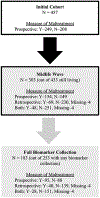Associations between childhood maltreatment and physiological dysregulation in adulthood: Methodological decisions and implications
- PMID: 37494760
- PMCID: PMC11893070
- DOI: 10.1016/j.chiabu.2023.106369
Associations between childhood maltreatment and physiological dysregulation in adulthood: Methodological decisions and implications
Abstract
Background: Childhood maltreatment is linked with health problems in adulthood. Theoretical models suggest that maltreatment leads to dysregulation in several bodily systems, and this has been corroborated using measures of physiological function (i.e., biomarkers). Methodological decisions involving the measurement of maltreatment and dimension reduction with respect to biomarkers (i.e., combining information across multiple measures) may influence research findings.
Objective: The present study compares associations between childhood maltreatment and adult physiological dysregulation using multiple dimension reduction approaches and measures of maltreatment.
Participants and setting: Participants were recruited, as children, to a prospective study of the correlates and consequences of childhood maltreatment. 253 participants were retained and provided biomarker data at midlife. Physiological dysregulation was operationalized with a conventional allostatic load approach and a novel statistical distance approach.
Methods: Regression models were employed with allostatic load or statistical distance as the outcome and prospectively or retrospectively measured child maltreatment as the primary predictor.
Results: When using allostatic load as the outcome, prospectively measured childhood maltreatment was positively associated with physiological dysregulation (b = 0.70, SE = 0.31, p = 0.02). When using statistical distance as the outcome, retrospectively measured childhood maltreatment was positively associated with physiological dysregulation (b = 0.69, SE = 0.19 p < 0.001).
Conclusions: We report a positive association between childhood maltreatment and physiological dysregulation at midlife. However, the significance and magnitude of effects varied with different maltreatment and physiological dysregulation measures. Further review of the methods used to study adult health conditions and their relation to childhood maltreatment is needed.
Keywords: Adult health; Allostatic load; Childhood maltreatment; Mahalanobis distance.
Copyright © 2023 The Authors. Published by Elsevier Ltd.. All rights reserved.
Conflict of interest statement
Declaration of competing interest None.
Figures



References
-
- Bellis MA, Hughes K, Ford K, Ramos Rodriguez G, Sethi D, & Passmore J (2019). Life course health consequences and associated annual costs of adverse childhood experiences across Europe and North America: A systematic review and meta-analysis. The Lancet. Public health, 4(10), e517–e528. 10.1016/S2468-2667(19)30145-8 - DOI - PMC - PubMed
Publication types
MeSH terms
Substances
Grants and funding
LinkOut - more resources
Full Text Sources
Medical

